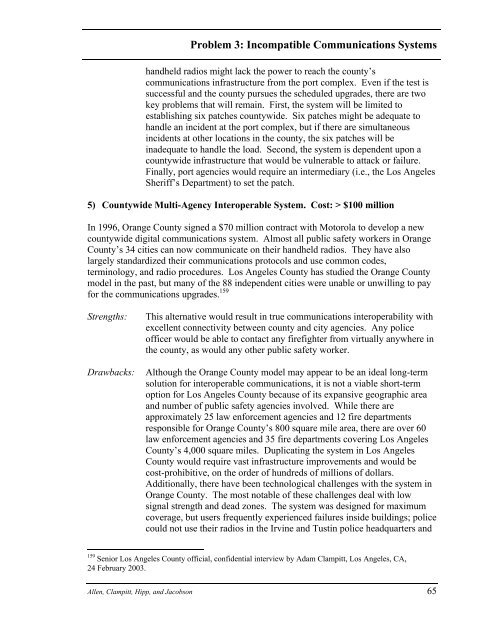Port Security Applied Policy Project - Belfer Center for Science and ...
Port Security Applied Policy Project - Belfer Center for Science and ...
Port Security Applied Policy Project - Belfer Center for Science and ...
You also want an ePaper? Increase the reach of your titles
YUMPU automatically turns print PDFs into web optimized ePapers that Google loves.
Problem 3: Incompatible Communications Systems<br />
h<strong>and</strong>held radios might lack the power to reach the county’s<br />
communications infrastructure from the port complex. Even if the test is<br />
successful <strong>and</strong> the county pursues the scheduled upgrades, there are two<br />
key problems that will remain. First, the system will be limited to<br />
establishing six patches countywide. Six patches might be adequate to<br />
h<strong>and</strong>le an incident at the port complex, but if there are simultaneous<br />
incidents at other locations in the county, the six patches will be<br />
inadequate to h<strong>and</strong>le the load. Second, the system is dependent upon a<br />
countywide infrastructure that would be vulnerable to attack or failure.<br />
Finally, port agencies would require an intermediary (i.e., the Los Angeles<br />
Sheriff’s Department) to set the patch.<br />
5) Countywide Multi-Agency Interoperable System. Cost: > $100 million<br />
In 1996, Orange County signed a $70 million contract with Motorola to develop a new<br />
countywide digital communications system. Almost all public safety workers in Orange<br />
County’s 34 cities can now communicate on their h<strong>and</strong>held radios. They have also<br />
largely st<strong>and</strong>ardized their communications protocols <strong>and</strong> use common codes,<br />
terminology, <strong>and</strong> radio procedures. Los Angeles County has studied the Orange County<br />
model in the past, but many of the 88 independent cities were unable or unwilling to pay<br />
<strong>for</strong> the communications upgrades. 159<br />
Strengths: This alternative would result in true communications interoperability with<br />
excellent connectivity between county <strong>and</strong> city agencies. Any police<br />
officer would be able to contact any firefighter from virtually anywhere in<br />
the county, as would any other public safety worker.<br />
Drawbacks: Although the Orange County model may appear to be an ideal long-term<br />
solution <strong>for</strong> interoperable communications, it is not a viable short-term<br />
option <strong>for</strong> Los Angeles County because of its expansive geographic area<br />
<strong>and</strong> number of public safety agencies involved. While there are<br />
approximately 25 law en<strong>for</strong>cement agencies <strong>and</strong> 12 fire departments<br />
responsible <strong>for</strong> Orange County’s 800 square mile area, there are over 60<br />
law en<strong>for</strong>cement agencies <strong>and</strong> 35 fire departments covering Los Angeles<br />
County’s 4,000 square miles. Duplicating the system in Los Angeles<br />
County would require vast infrastructure improvements <strong>and</strong> would be<br />
cost-prohibitive, on the order of hundreds of millions of dollars.<br />
Additionally, there have been technological challenges with the system in<br />
Orange County. The most notable of these challenges deal with low<br />
signal strength <strong>and</strong> dead zones. The system was designed <strong>for</strong> maximum<br />
coverage, but users frequently experienced failures inside buildings; police<br />
could not use their radios in the Irvine <strong>and</strong> Tustin police headquarters <strong>and</strong><br />
159 Senior Los Angeles County official, confidential interview by Adam Clampitt, Los Angeles, CA,<br />
24 February 2003.<br />
Allen, Clampitt, Hipp, <strong>and</strong> Jacobson 65
















